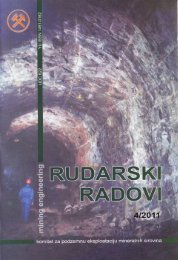Institut za rudarstvo i metalurgiju Bor
Institut za rudarstvo i metalurgiju Bor
Institut za rudarstvo i metalurgiju Bor
Create successful ePaper yourself
Turn your PDF publications into a flip-book with our unique Google optimized e-Paper software.
COMMITTEE OF UNDERGROUND EXPLOITATION OF YU ISSN: 1451-0162<br />
THE MINERAL DEPOSITS UDK: 622<br />
UDK: 622.337:504.045(045)=20<br />
Dejan Sokolović*<br />
RISK IDENTIFICATION IN THE MINE DESIGN, EXPLOITATION<br />
AND COMBUSTION OF OIL SHALE<br />
Abstract<br />
Environmental protection at the recent level of development, both in developed and developing<br />
countries, has became necessary, due to more intensive energy development, the impacts on it are<br />
much more complex. The problem is particularly complex because a compromise between the<br />
energy policy and environmental policy has to be achieved. Practically, all energy sources and<br />
plants have more or less impact on the environment.<br />
Development in production of primary and secondary energy contributes to the increased environment<br />
pollution. Therefore, in all countries the legislative and other norms treat the protection<br />
of air, water, soil, noise protection, etc., among other things, and power plants. The biggest impact<br />
on the environment is the production of secondary energy, especially electricity in the power<br />
plants. All problems of environment pollution are also present in the construction of thermal<br />
power plants on oil shale, with perhaps greater intensity of pollution due to the quality and composition<br />
of oil shale. This paper deals with harmful effect of exploitation and combustion of oil<br />
shale on the environment and risk identification of risk in overall utili<strong>za</strong>tion of oil shale.<br />
Key words: oil shale, environmental protection, exploitation, combustion, gasification<br />
INTRODUCTION<br />
Oil shales are the rock layers, which contain<br />
the material that is practically the forerunner<br />
of oil. When this material is overheated,<br />
mainly kerogen, it could be distilled<br />
from rocks in the oil. By enrichment and<br />
refining of this distilled liquid material, various<br />
kinds of useful fuel could be obtained.<br />
Oil shale could be exploited by surface, underground<br />
and using the modern methods of<br />
underground gasification.<br />
Depending on which technology is in<br />
use, the exploitation and combustion of oil<br />
shale is associated with large disturbances<br />
and risks in the natural habitat, underground<br />
* Ministry of Mining and Energy<br />
and surface sources, air quality and climate.<br />
The permanent impacts on topography and<br />
flora and fauna are expected as the result of<br />
commercial exploitation and processing of<br />
oil shale.<br />
In a case of surface exploitation, the<br />
used, i.e. processed oil shale (waste) has a<br />
great impact on contamination of underground<br />
water (have dramatically higher<br />
concentration of mineral salt than slate,<br />
and may also contain other toxic substances).<br />
In a case of underground (in-situ)<br />
the exploitation, the process involves a<br />
risk on groundwater contamination [3].<br />
No 1,2010. 141<br />
MINING ENGINEERING



